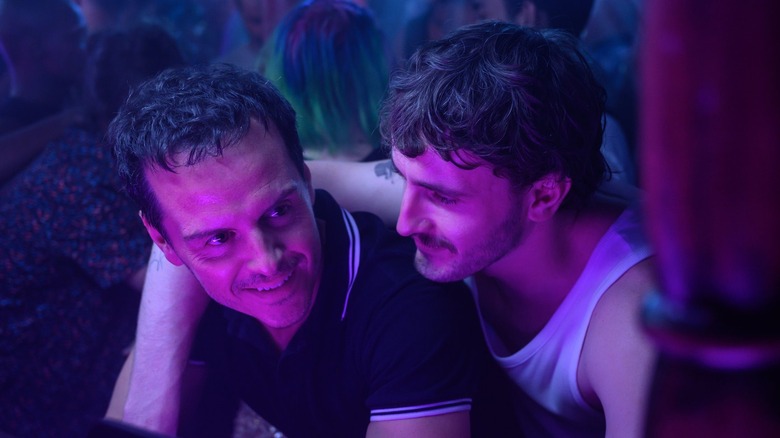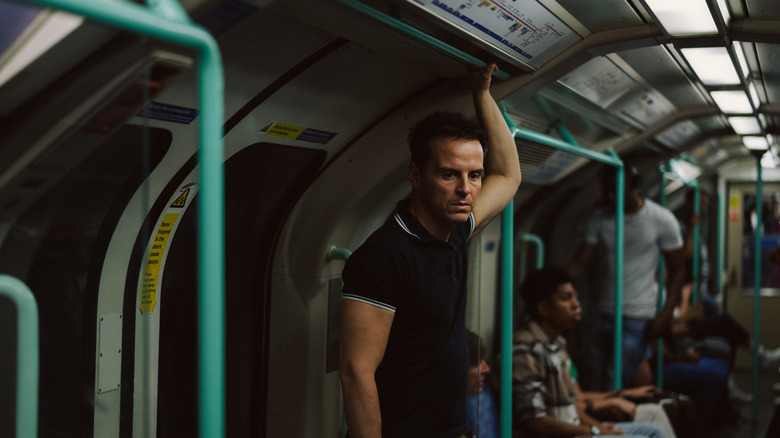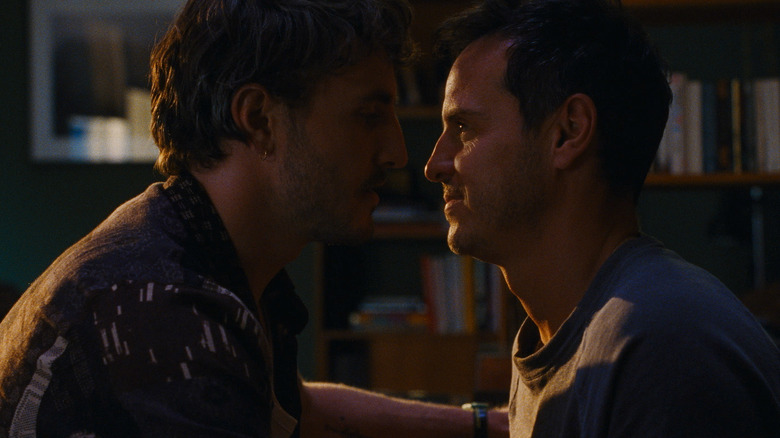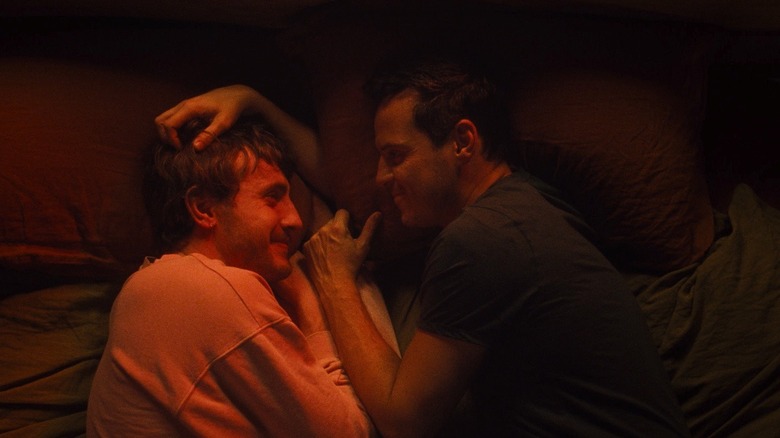All Of Us Strangers Cinematographer On Maximizing The Movie's Emotional Wallops [Exclusive Interview]
This post contains light spoilers for "All of Us Strangers."
Andrew Haigh's "All of Us Strangers" is one of the most beautiful films of the year. Andrew Scott plays Adam, a screenwriter living in a largely empty London high-rise, who forms an unexpected romance with a fellow tenant named Harry (Paul Mescal). Adam is trying to write a story about his parents, who died before Adam was a teenager, but when he visits his suburban childhood home, something extraordinary happens: His parents (Claire Foy and Jamie Bell, both extraordinary) are still living in the house, and they're the same age they were when they died. In this surrealist part of the story, Adam, now older than his own parents, gets the opportunity to have the conversations with them he always wanted to, but never could.
That premise may sound slightly convoluted, but it's a testament to Haigh's fantastic script and his patient filmmaking style that it's all easy to track and emotionally potent as Adam wanders through this almost dream-like experience and gets the cathartic release of speaking with his dead parents while forming a budding relationship with this new man in his life.
I had the opportunity to speak with Jamie Ramsay, the film's cinematographer, about the gorgeous work he did capturing Haigh's story on film. We talked about the process of shooting on 35mm film, how Ramsay worked with the cast, the "happy accidents" that can sometimes happen on a set, the most difficult scene for him to capture, and much more.
Note: This interview has been lightly edited for clarity and brevity.
'It had to almost be alive, in a sense'
Congratulations on the movie. I was very moved by it. I want to start by asking: When you read a script for the first time, are you picturing shots and camera moves in your head, or does that come later for you?
No, when I first read a script, it's never as specific as that for me. My first reading of a script is sort of the birthing of the feeling of the movie. So I never want to stop and start, and I purposely don't even write anything down initially because I want to just give it a really intuitive, holistic look in the beginning. But that first reading is so important for me, because that truly is when, out of darkness, a feeling for the film is born. And it's that feeling that allows me to either believe in the fact that I can join the project and put all of myself into it or not. Then it's also that feeling that, whether it's consciously or subconsciously, it's a feeling that dictates ultimately how the thought process goes in order to figure out that sort of language.
Gotcha. Can you tell me what your experience was like reading this script and talking with Andrew about the visual approach that he had in mind for the story?
Yeah, so I had the good fortune of having quite a lot of time upfront with Andrew, and it had something to do with, I guess a period during post-Covid and just being able to have a fairly generous run-up. But we spent a lot of time together, very passively, meeting for coffee, meeting at his place, and really firstly just getting to know him and also just getting to know the script and the characters and just speaking for hours and hours and just tossing ideas around between us. The wonderful thing about Andrew is that he's got a very specific and educated position on how he sees a film, but it's not prescriptive in the sense that he knows exactly how the visuals should be or how it should look. So I guess our courting phase with regards to the concept was hours and hours of talking and just figuring out what felt right in certain moments, what sort of language felt right.
The idea of shooting on 35 mil came up quite early in those talks because it became really obvious that a movie like this needed to have ... it needed to have a piece of nature to it. It had to feel as if it came from the ground, in a way. It had to have a slightly nostalgic feel. It had to almost be alive, in a sense. You know? So yeah, those conversations happened and obviously, Andrew is a wonderful helmsman, so he would always guide this myriad of ideas that would come out of these conversations into the right point, and I think that's definitely a mark of a wonderful director.
Did you look at any particular movies or TV shows as touchstones or inspirations for what you were trying to do here?
We didn't overtly look at sort of content in that sense, but there was one movie that we sort of circled around and it was "Cries and Whispers," which obviously, at its time, was quite groundbreaking in terms of its visual style. But there was something about that movie that felt organic — it certainly had a style, but it was a way of exploring a scene and allowing the hand of the cameraman to be a paintbrush, in a sense, in terms of the operating and the way the lens moved, and the way the camera moved. For us, that was important because with the way Andrew worked, whenever he was directing actors, I would pay such close attention because ultimately he was directing me. So I would understand how that scene should move and how it should feel. And the sort of camera language that "Cries and Whispers" used, it was a good reference point for us because it certainly did the same thing, and I think ultimately it became, I guess, a signature of the movie.
'It was quite important to deal with it as subtly as possible'
You mentioned the actors. The relationship between actors and a cinematographer is extremely important. Can you tell me about working with this quartet of excellent actors? Did you need to adjust to the different ways that each of them worked? How did that work for you?
What I will say with regards to that is, one of the most important things for me as a DoP who likes to operate is to create a sort of a bubble of comfort with the cast, which comes in obviously in the lead-up to the film where you meet the cast and you first get to know them. Because as an operator, you're the closest person to the cast member — closer than anybody else besides perhaps the other cast. So it's so important to have an energy and a feeling around you that allows them a safe space and a trust to do what they need to do.
There's also a hallowed experience that happens between you and cast in wonderful moments where you can see them going somewhere, you can feel it, and you allow them to do it, and then they give you more, and you kind of work off each other. Often a cast member will look up to you first and be like, "How was that?" And you're like, "That was f**king great. Well done." So yes, there's a trust and then there's an honesty that needs to happen between operator and cast. I think Andrew's the kind of director who is all for that, and I think feels safe to allow that relationship to happen. And I think in doing so, there's definitely an authenticity to the relationship and the moments that come across.
Could you pinpoint different acting styles or different needs from the different performers? I mean, all four of the main quartet of actors here are just unbelievable in this movie. And I think a lot of that has to do with, like you said, the environment that you guys created to allow them to do some of their best work. I was wondering if one person needed 10 takes to ramp up and get to where they needed to be, whereas another person only needed one take and they were right out of the gate or anything like that. If you could tell me what your experience was like watching these people work so closely.
Yeah, I think what was interesting is I think ... I wouldn't say Andrew Scott is a method actor, but I certainly observed him become more and more the character that was on the page, in a sense. Whereas Paul Mescal, he's got a way more playful energy to him. So whenever there was the scenes with the two of them, you would have a slightly somber, melancholic presence of Andrew, and then you'd have Paul, who would come into the room and he'd be so curious about what was going on, and he would ask questions. Andrew beautifully allowed him that space, and ultimately when they were in the scene together, they would play off each other.
And obviously, ultimately it's Andrew's film. So whenever the other actors came into the theater of play, all of them were super respectful about joining the process. I can actually attribute that to the way Andrew Haigh sets the tone on his set, because it's a tone of respect, it's a warm tone, it's a tone of "best idea first" and "creativity first." So I think when somebody comes into that energy, they've got no other choice really than to join it. So yeah, that was a really beautiful experience to have.
Yeah, that's great. What kind of juxtapositions did you talk about in terms of the look of the movie when Andrew Scott's character is in his apartment versus when he returns home and interacts with his parents?
Obviously we're kind of dealing with the real life versus this kind of surreal experience that he has. For me, it was quite important to deal with it as subtly as possible, and that was also a strong note that came from Andrew. He never wanted anything to be particularly overt. So what we wanted to do is, the apartment, we wanted to create quite a stark, real feel, which is inherent to these high-rise, new builds and cityscapes. There's a coldness to them, there's a starkness to them that doesn't feel particularly welcoming. We wanted to treat that as close to reality as possible.
The lighting fixtures we used were sort of in the world of LED, and we shot on a virtual backlot, so our backdrop was LED. Even though our master acquisition format was 35 mil, we wanted to sort of differentiate that to the location-based stuff. Whenever we went back in time or into the surreal world, we sort of opted to use tungsten lighting and we opted to use tungsten practicals and just treat it in a much softer way. Even the way we filtrated the lenses was much softer, but again, not wanting it to be a particularly obvious separation.
This movie is emotionally devastating on a number of different levels. And those emotional moments I really think would not be the same without your lighting and camera work to highlight and frame just the right things at just the right time. So I'm wondering if there's a secret to maximizing the impact of key moments like that from a visual perspective.
Absolutely. For me, it starts from a deep understanding of what the scene needs and what feeling the scene needs. That, again, comes from lengthy discussions with the director. And then sitting in on the blocking and the rehearsal for me is vital, because a scene can evolve so drastically in that phase because now you've got a multitude of heads coming together and figuring out the way to do it. So in the process of blocking and rehearsing, it becomes way more obvious what the intent of the scene is, and it's very important for me to be present during that phase. Often you'll look at the director and be like, "Okay, hold on a second. Perhaps the way to do this isn't what we discussed. Maybe we should do something like this."
And I'm a strong believer in if you are honest with yourself and you know what needs to be done and you're honest with everybody around you during that phase, what you come up with and what is sort of channeled through you naturally will be the right way to do it. And honestly, just being as reactive as possible to the mood and the feeling that's coming across through the performance and through the direction, and sort of acting accordingly.
'I really love the opening shot of the film'
I'm always curious when talking to DPs about how much intentionality goes into matching the thematics of the movie with the visuals of the movie in terms of light and shadow and how that plays. Are you guys actively thinking about, "Okay, let's make sure that a shadow casts on this character's face because that represents the inner turmoil that he's going through at this moment?" Or is that just all stuff that is applied to the movie afterwards by critics and audiences?
Do you know what? There's always happy accidents, Ben, but I'm a big believer in you create those happy accidents because you're prepared for them. So what I would say is that, for instance, there's a scene in the nightclub where it's after they've gone to the bathroom and they've taken the ketamine. We really wanted the lighting design to transition from heightened club lighting to something that was completely not believable within a club environment. There's a scene where the two of them come together and they kiss, and there's this low-angle backlight that comes through them, almost like a heavenly gate that's opened up.
And obviously that's not going to be there in a nightclub, but I knew that I wanted the fixtures that could do something like that because I knew there would be this moment and it sort of came together. For me, I really feel that moment of them together and pushing in on the zoom of them kissing there, it's for me how you would ultimately imagine that moment to be. So yeah, happy accidents do happen, but I think you have to be prepared for them, and that comes with understanding and preparation, right?
That's awesome. Was there a scene or a moment that proved to be the most difficult for you to capture?
Yeah, I think one of the hardest scenes, and for me, actually, was one of my favorite scenes, is when he leaves the club and he comes home to his parents' house and he climbs in bed with his mom and his dad. And after a lot of discussion, Andrew and I, we wanted to do it as a single-take shot. What was really tough about that is that it was a location. It was Andrew's old parents' house. It was a location in London. The rooms were tiny, the ceilings were super low, and we are shooting on big old 35 mil gear, so it needs proper rigging and proper operation.
And it was really tricky because first and foremost, it was a physical ballet between all the cast members. It was a ballet between my amazing grip, Kevin Frazier, to move the camera above them silently and as unobtrusively as possible. And then it was me operating the zoom to kind of get out of shots and go into clean shots and all of that whilst adding police lights, whilst transitioning into different moments. I think it was probably like a five-minute ballet. And then on top of that, the actors had to perform. So that was really tough, because when actors need to perform, the last thing I want to do is have to do this physical ballet on top of it. But they all kind of believed and they all bought into it. And for me, it's one of the most beautiful scenes because it is truly the one that exhibits the tragic loneliness of the story, because ultimately there he is alone in bed as a little boy in his pajamas with both of his parents gone and the lover that he thought he had wasn't there anymore. So right there and then, that's the movie.
Yeah, absolutely. When you look back on making "All of Us Strangers," is there a shot or a moment, different from that one, that you're personally the most proud of or that resonated with you the most?
Let me think. You know what? I really love the opening shot of the film, which is ... you've seen the movie, but it's a sunset landscape of London, and the sun happens to catch the glass on a building and throw a beautiful glow into the lens. And ultimately, it turns out to be the reflection in the window and Andrew sort of appears in the glass there. The reason why I love it so much is because the way that feels is, to me, it exhibits that bizarre feeling of loneliness in a busy space.
Some of the loneliest moments I've ever had is when I've been in the busiest cities in the world. You have all of these little spaces and you have a single person in a window, and you look at them off the street and you look up at them in the window and you wonder, what is that person's life? And then they're looking down and they're probably wondering. It's this sort of forced loneliness that busy crowds create. And I just think the metaphor that exists in that shot is beautiful and it's deep, and I think it's probably one of my favorite.
I love that. Is there anything you can tell me about projects that you have coming up? Anything that you're working on that you're excited about?
Yeah, so I've just finished a film called "William Tell," which is as different to "All of Us Strangers" as it possibly could be. But it's a period costume drama about the emancipation of the Swiss during the Austrian occupation in the 1400s. [laughs] So it's very, very different, but it certainly exhibits a different side of a DP's skill, in terms of scale and multiple cameras and big scenes and all of that sort of stuff. So it's challenging in its own right, and I think it's going to come out beautifully. And then, yeah, previous to that was a film I did in Los Angeles with an amazing director named Hallie Meyers-Shyer. And it's called "Goodrich," with Michael Keaton, and I think that's going to be beautiful as well. That was also a wonderful working relationship, too. So yeah, there's a couple coming out, and I'm certainly most looking forward to seeing how the world's audiences feel about "All of Us Strangers."
Definitely. I'm excited to share it with the /Film audience because I think this one ... I mean, if it hits people the same way that it hit me, it's going to leave a significant mark on folks. So I'm excited to have had the opportunity to talk to you today, and thank you so much for your time.
Ben, thank you so much. I'd just love to say as a last thing is that, as filmmakers, especially for me as a DP, my main aim with what I do is just to leave that mark in some moment, in some way. And if I've achieved that, then that's success for me.
"All of Us Strangers" is in theaters now.



